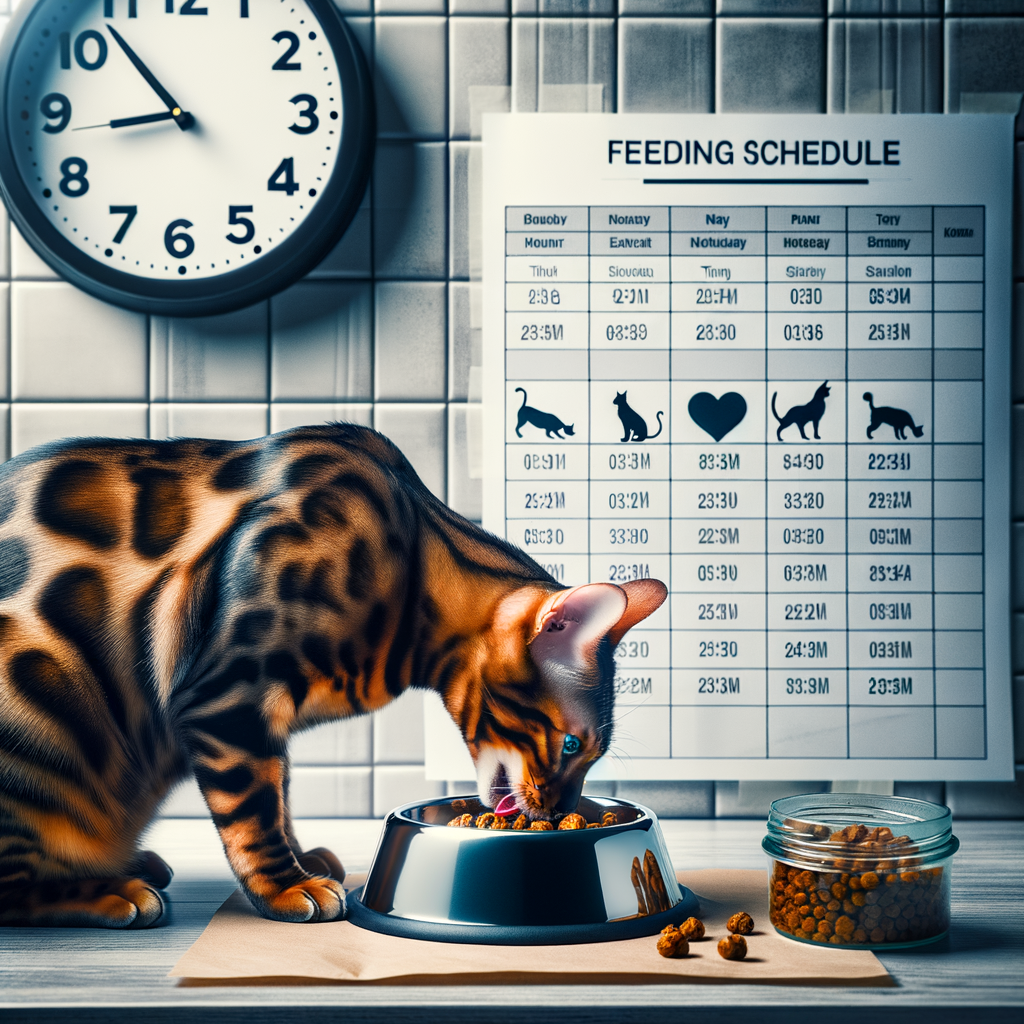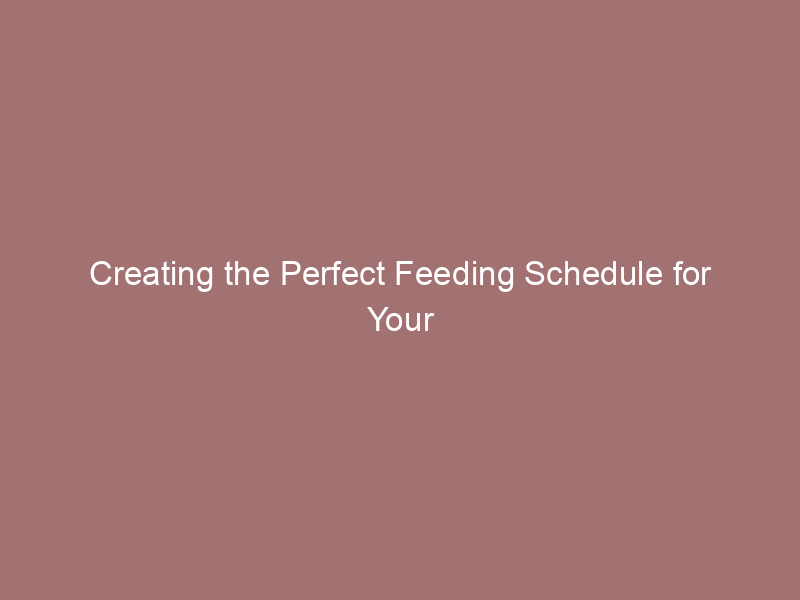
Introduction: Your Bengal Cat’s Dietary Needs
Bengal cats have unique dietary needs that differ from other cat breeds. Let’s explore why a balanced diet is important and what makes Bengal cats’ dietary needs special.
- Importance of a balanced diet for Bengal cats: A balanced diet ensures your Bengal cat gets all the nutrients they need. This helps them stay active, maintain a healthy weight, and avoid health problems. Just like humans, cats need a mix of proteins, fats, vitamins, and minerals.
- Unique dietary needs of Bengal cats: Bengal cats are known for their high energy levels and muscular bodies. They need more protein than other cats to support their active lifestyle. Additionally, Bengal cats may have sensitive stomachs, choose high-quality, easily digestible food.
A Comprehensive Bengal Cat Feeding Guide
How Often to Feed Bengal Cats
- Feeding frequency for kittens:
Bengal kittens need to eat more often than adult cats. They are growing quickly and need extra nutrients. Typically, you should feed them 4-5 times a day. This helps them get the energy they need to grow strong and healthy. - Feeding frequency for adult cats:
Once your Bengal cat is fully grown, you can reduce the number of meals. Adult Bengal cats usually need to eat 2-3 times a day. This helps maintain their energy levels without overfeeding.
Bengal Cat Feeding Times
-
Best times to feed your Bengal cat
The best times to feed your Bengal cat are in the morning and evening. Cats are natural hunters and tend to be more active during dawn and dusk. Feeding them during these times aligns with their natural instincts.
For example, you can feed your Bengal cat at 7 AM and 7 PM. This schedule helps maintain their energy levels throughout the day and night. According to a study by the Cat Behavior Research Group, cats that are fed at consistent times are generally healthier and happier.
-
Feeding routine consistency
Cats thrive on routine, and irregular feeding times can lead to stress and digestive issues. Make sure to feed your Bengal cat at the same times every day.
For instance, if you choose 7 AM and 7 PM as feeding times, stick to this schedule. A consistent routine helps your cat know when to expect food, reducing anxiety and promoting better digestion. According to Wikipedia, a regular feeding schedule can also help in preventing obesity and other health problems.
| Feeding Time | Reason |
|---|---|
| 7 AM | Aligns with natural hunting instincts |
| 7 PM | Maintains energy levels |
Bengal Cat Food Portions
-
Portion Sizes for Kittens
Kittens need more food than adult cats because they are growing. A Bengal kitten should eat about 3-4 small meals a day. Each meal should be around 1/4 to 1/3 cup of kitten food. This ensures they get enough nutrients to grow strong and healthy.
Age Portion Size Frequency 0-3 months 1/4 cup 4 times a day 3-6 months 1/3 cup 3 times a day 6-12 months 1/3 cup 2-3 times a day Tip: Always ensure fresh water is available for your kitten.
-
Portion Sizes for Adult Cats
Adult Bengal cats have different needs. They should eat about 2 meals a day. Each meal should be around 1/2 cup of adult cat food. This helps maintain their energy and health.
Weight Portion Size Frequency 8-10 lbs 1/2 cup 2 times a day 10-12 lbs 2/3 cup 2 times a day 12-15 lbs 3/4 cup 2 times a day Note: Adjust portions if your cat is very active or less active.
Creating a Bengal Cat Diet Plan
Best Food for Bengal Cats
-
Recommended brands and products
-
- Royal Canin Bengal Formula: This brand offers a special formula designed for Bengal cats. It includes high protein content and nutrients.
- Blue Buffalo Wilderness: Known for its natural ingredients, this brand provides grain-free options rich in protein.
- Hill’s Science Diet: This brand is trusted for its balanced nutrition and high-quality ingredients.
-
-
Homemade food options
- Chicken and Rice: Cooked chicken and rice can be a simple and healthy meal for your Bengal cat. Ensure the chicken is boneless and skinless.
- Fish and Vegetables: Cooked fish like salmon or tuna mixed with steamed vegetables such as carrots and peas can provide a balanced diet.
- Turkey and Sweet Potato: Cooked turkey combined with mashed sweet potatoes is another nutritious homemade option.
| Food Type | Benefits |
|---|---|
| Royal Canin Bengal Formula | High protein, essential nutrients |
| Blue Buffalo Wilderness | Natural ingredients, grain-free |
| Hill’s Science Diet | Balanced nutrition, high-quality ingredients |
| Homemade Chicken and Rice | Simple, healthy meal |
| Homemade Fish and Vegetables | Balanced diet, rich in protein |
| Homemade Turkey and Sweet Potato | Nutritious, easy to prepare |
Bengal Cat Nutrition
-
Necessary nutrients and their sources
| Nutrient | Source |
|---|---|
| Protein | Chicken, fish, turkey |
| Fat | Fish oil, chicken fat |
| Vitamins | Vegetables, fruits |
| Minerals | Bone meal, fish |
-
Supplements and their role
- Fish Oil: Helps with a shiny coat and healthy skin.
- Probiotics: Good for digestion and gut health.
- Multivitamins: Ensure they get all necessary vitamins.
Implementing a Bengal Cat Meal Schedule
Bengal Kitten Feeding Schedule
- Feeding frequency and portion sizes: Bengal kittens have small stomachs but high energy needs. They should be fed 4-5 times a day. Each meal should be about 1/4 to 1/3 cup of high-quality kitten food. This ensures they get enough nutrients to support their rapid growth.
- Transitioning to adult food: Around the age of 12 months, you can start transitioning your Bengal kitten to adult cat food. Gradually mix the adult food with the kitten food over a week. This helps prevent digestive issues. By the end of the week, your kitten should be fully on adult food.
| Age | Feeding Frequency | Portion Size |
|---|---|---|
| 0-3 months | 5 times a day | 1/4 cup per meal |
| 3-6 months | 4 times a day | 1/3 cup per meal |
| 6-12 months | 3-4 times a day | 1/3 cup per meal |
| 12 months and older | 2-3 times a day | Transition to adult food |
Adult Bengal Cat Feeding Schedule
-
Feeding Frequency and Portion Sizes
Adult Bengal cats typically need to be fed twice a day. This helps maintain their energy levels and prevents overeating. Each meal should be measured to ensure proper portion sizes.
Here is a simple table to guide you:
Cat Weight (lbs) Daily Food Amount (cups) 8-10 1/2 – 3/4 10-12 3/4 – 1 12-15 1 – 1 1/4 Monitor your cat’s weight and adjust portions as needed. Overfeeding can lead to obesity, while underfeeding can cause malnutrition.
-
Adjusting the Diet for Senior Cats
As Bengal cats age, their dietary needs change. Senior cats (age 7 and older) may require fewer calories but more nutrients to support their aging bodies.
Consider the following adjustments:
- Protein: Ensure high-quality protein to maintain muscle mass.
- Fiber: Increase fiber to aid digestion and prevent constipation.
- Hydration: Older cats may need more water. Wet food can help with this.
Common Challenges in Bengal Cat Feeding
- Overfeeding and Obesity:
Bengal cats are very active, but they can still become overweight if they eat too much. Obesity can lead to health problems like diabetes and joint pain. To avoid overfeeding, measure your cat’s food and stick to a feeding schedule.
Tip: Use a measuring cup to ensure you give the right amount of food. - Underfeeding and Malnutrition:
If a Bengal cat doesn’t get enough food, it can suffer from malnutrition. This can make them weak and sick. Make sure your cat eats a balanced diet with enough protein, fats, and vitamins.
Tip: Consult your vet to find the best food for your Bengal cat. - Picky Eaters and How to Handle Them:
Some Bengal cats can be picky eaters. They might refuse to eat certain foods, which can be frustrating. To handle picky eaters, try different types of food to see what they like. Sometimes, warming the food slightly can make it more appealing.
Tip: Avoid giving too many treats, as this can make them even pickier.
Ensuring Your Bengal Cat’s Health Through Proper Feeding
-
Summary of key points
- Understand your Bengal cat’s dietary needs.
- Create a balanced diet plan.
- Stick to a regular meal schedule.
- Be aware of common feeding challenges.
-
Final thoughts and advice
Proper feeding is essential for your Bengal cat’s well-being. Always provide fresh water and high-quality food. Monitor their weight and health regularly. If you notice any changes, consult your vet.






